If you’re like me, you regularly hear from friends who brag about how they’ve successfully timed the market in the past. What these folks will never tell you is the number of times they’ve missed the boat!
Take last week, when millions of folks were parked on the sidelines, terrified (thanks to scaremongering media reports) that the July CPI print would come in worse than expected, triggering a selloff.
Of course, we now know that the exact opposite happened—and I’m guessing you won’t hear from your friends who failed to grab that bounce!
Look, when other folks do manage to pull off this trick, I salute them. It always feels good to win a bet. But to be honest, the odds of timing the market successfully equate to a coin flip (at best).
We Prefer to Outperform All the Time—on Dividends Alone
When it comes to investing for the long haul, we contrarian dividend investors take a different approach. At my CEF Insider service—which is devoted to high-yield closed-end funds (CEFs)—we like to hold on to our CEFs, many of which yield 7% or more and pay monthly, through rising and falling markets. (I’ll reveal three such funds, with yields up to 9.2% and trading at bargain prices, below.)
If you’ve taken a look at the stock market’s historical returns over the long term, you’ll know that they come in around 7% on average, in dividends and price gains, depending on the period you’re looking at. With our CEFs, we’re matching, if not beating, that figure just in dividends.
There’s a lot more to CEFs than dividends, though. These funds boast a built-in indicator that’s unique to them called the “discount to net asset value,” or “discount to NAV,” for short. It tells us exactly when a CEF is cheap and when it’s pricey.
Here’s how it works—and how you can use it to add some nice bonus upside, on top of the “natural” gains (and high dividends) you’d pull in from CEFs on their own.
The Deal on the Discount
The discount to NAV stems from the fact that, since CEFs have more or less the same number of shares for their entire lives, they’re often priced differently on the open market than the value of all of the shares they hold. And very often they trade at discounts—deep discounts at that.
Stick with me here because paying close attention to the discount to NAV can unlock some serious gains in CEFs, for a couple of reasons.
The first, obviously, is that you’re getting a deal: a CEF trading at a 10% discount to NAV means you’re essentially paying 90 cents on the dollar for the stocks, bonds, REITs or whatever the fund holds. That on its own draws in new investors, who bid up the price.
The second—and related—benefit is the ability to cash in on a discount as it narrows and (hopefully) flips to a premium. When that happens, it acts like an afterburner on a CEF’s market price.
How a Closing CEF Discount Drove a Fast 145% Gain
To see the dramatic effect a closing discount can have, consider the BlackRock Science and Technology Trust (BST), which focuses on big-name tech stocks like Microsoft (MSFT), Apple (AAPL) and Mastercard (MA). In a little more than two years, BST’s deep discount flipped to an 8.6% premium as the stock market gained ground and income-seeking investors took note of the fund’s payout, which yielded around 6% at the time.
BST’s Discount Surges Into Premium Territory …
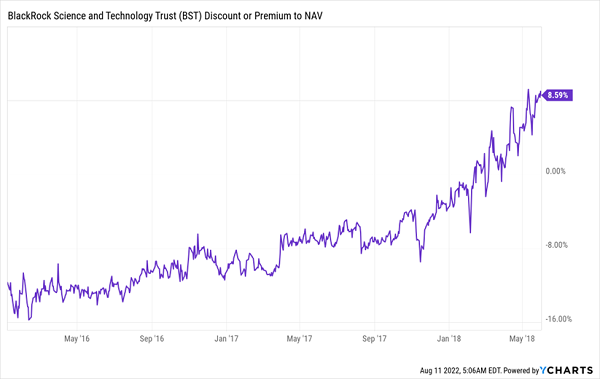
The result was a massive “bonus” gain on top of the natural increase in BST’s portfolio. To see what I mean, look at the chart below.
… and Gives Its (Already Huge) Returns an Extra Kick

The orange line above shows how much an investor would have profited if they’d bought the shares held by BST individually, and not the fund itself. The blue line is the actual profit BST shareholders got, which we can see is about one-and-a-half times the size of the individual stocks’ profits.
That extra gain is exactly what can happen when you buy a CEF at a discount!
And these days, there are still plenty of deep-discounted CEFs out there, even with the market bouncing from its recent lows. Let’s look at three, which sport discounts as low as 16.2% and yields all the way up to 9.2%.
CEF Pick No. 1: A 9.2% Oil and Gas Dividend With “Discount-Driven” Upside
First up is the Kayne Anderson NextGen Energy & Infrastructure Fund (KMF), a 7.5%-yielder trading at that huge 16.2% discount I just mentioned. Big as that discount is, it’s already starting to shrink (it was 20% recently), and the fund is posting strong total returns, both on a market-price basis (in purple) and a NAV basis (in orange) below.
KMF’s Portfolio—and Market Price—Soar
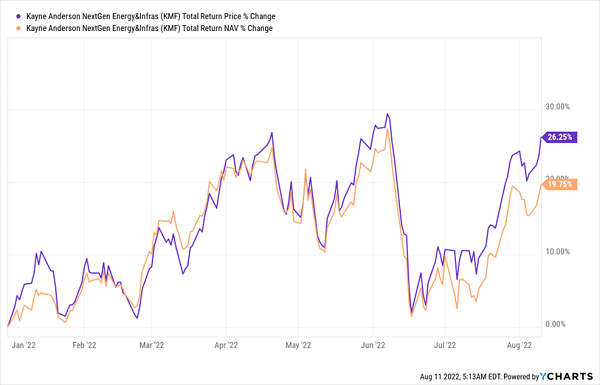
That’s not surprising given (still) tight oil markets and the fact that the fund specializes in master limited partnerships (MLPs), high-yielding firms that mainly operate oil and gas pipelines and storage facilities.
The thing to keep in mind with KMF is that the above gain came despite the fact that the fund’s discount remains unusually large: it’s far bigger than the 3.8% average discount among CEFs broadly. But that’s changing fast and will likely continue to in the long term, as oil supplies remain tight.
CEF Pick No. 2: Blue Chip Stocks Yielding 5.8% (and Selling for 89 Cents on the Dollar)
Another compelling cheap fund is the 5.8%-yielding Gabelli Dividend & Income Fund (GDV), which has bounced nicely since the market’s June bottom on both a NAV and market-price basis. It looks set to go higher still, thanks to its steep 11% discount.
GDV Rides the Recovery
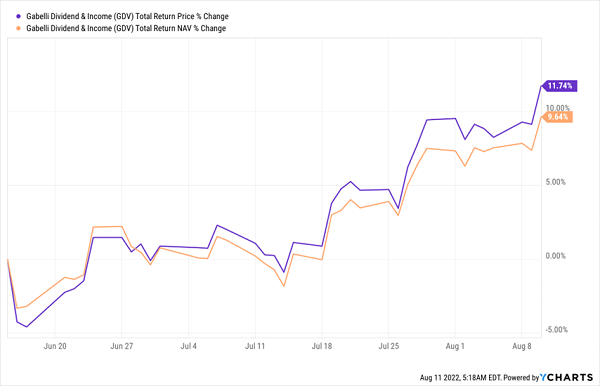
GDV has done well in the recent rebound, thanks to high-cash-flow holdings like Alphabet (GOOG), Swedish Match (SWMA), American Express (AXP), Mastercard (MA) and Microsoft (MSFT).
The fund, which is run by value-investing legend Mario Gabelli, has begun to see more investors buy in, while the fundamental value of its portfolio has also climbed about 10%. Meantime, its discount hasn’t closed very much at all, so we can expect more upside as investors take note of the deal on offer here and buy in.
CEF No. 3: A Terrific Bargain in Real Estate (Yielding 9.2%)
The final fund to consider is the Principal Real Estate Income Fund (PGZ), which has another steep discount, at 9.5%, and also an incredible yield, at 9.2%. Big discounts like that tend to disappear fast in rising stock markets, and PGZ is a good example of that.
In 2017, the fund, which mainly invests in real estate loans and mortgages, saw huge demand as the real estate market strengthened. Accordingly, PGZ’s discount shrank dramatically.
PGZ’s Rising Demand
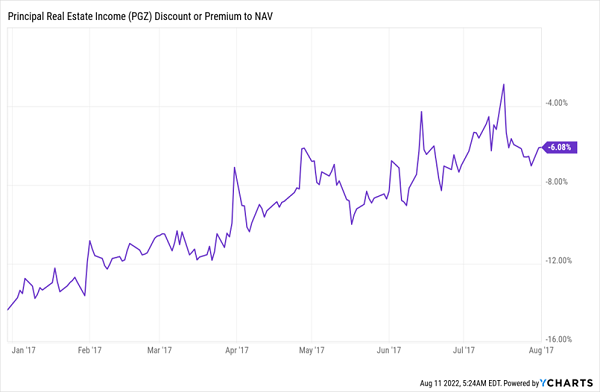
That, of course, translated into big profits for shareholders over that same time period, as the fund’s NAV and market price took off.
PGZ Delivers Huge Gains Fast
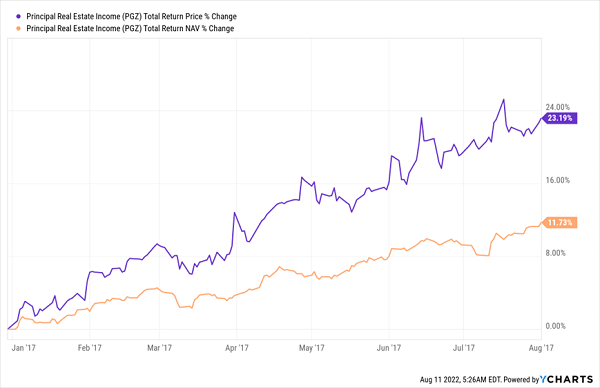
We’re already seeing a replay of this story in 2022. Check out how much more PGZ’s price return is exceeding its NAV return.
PGZ Becoming a Hot Commodity
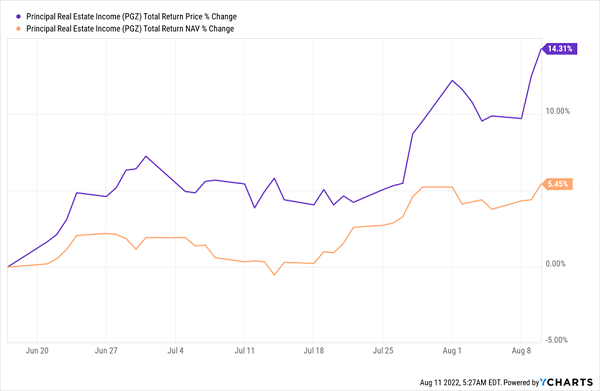
Even so, PGZ’s discount is still hovering near 10%, suggesting the possibility of double-digit capital gains as it disappears, on top of the profits from the market’s recovery for contrarians looking to the other side of these rate hikes, to an (inevitably) recovering real estate market. And you’d get a 9.2% dividend while you wait.
Slower-Moving CEF Market Gives Us an Edge Stock Investors Can Only Dream Of
The other thing that’s terrific about CEF investing is that folks who invest in these funds tend to be a conservative bunch, so they’re slower to respond to changes in the market—either positive or negative.
This means that when stocks change direction—as they did in a big way with last week’s CPI print—we have some extra time to buy in. The CEF market isn’t like stocks, where buying the dip requires lightning-fast action, good timing and, let’s be honest, a lot of luck.
With CEFs, we can bide our time, zero in on the biggest discounts and highest, safest dividends, and then buy in. It’s a tremendous advantage that, combined with our CEFs’ discounts to NAV, can deliver a potent mix of big dividends and strong price gains.
4 (Still!) Deep-Discounted CEFs Set to Bounce (and Pay Us 8.5% Dividends)
I’m telling you this now because in the wake of last week’s positive CPI report, this “time lag” has set up a terrific opportunity for us to move into my 4 favorite CEFs. All 4 still trade at deep discounts—so deep that I’m expecting 20%+ price upside here—and hand us a rich 8.5% average dividend, too!
The kicker: these 4 bargain funds pay dividends monthly.
But our chance to buy these funds won’t last much longer. Click here and I’ll tell you more about my CEF-investing strategy and give you access to an exclusive Special Report naming all 4 of these bargain-priced 8.5% monthly payers!

Recent Comments